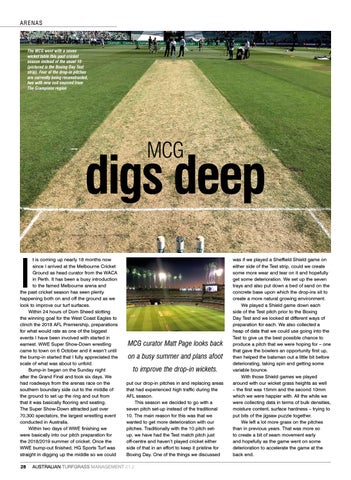ARENAS
The MCG went with a seven wicket table this past cricket season instead of the usual 10 (pictured is the Boxing Day Test strip). Four of the drop-in pitches are currently being reconstructed, two with new soil sourced from The Grampians region
MCG
digs deep I
t is coming up nearly 18 months now since I arrived at the Melbourne Cricket Ground as head curator from the WACA in Perth. It has been a busy introduction to the famed Melbourne arena and the past cricket season has seen plenty happening both on and off the ground as we look to improve our turf surfaces. Within 24 hours of Dom Sheed slotting the winning goal for the West Coast Eagles to clinch the 2018 AFL Premiership, preparations for what would rate as one of the biggest events I have been involved with started in earnest. WWE Super Show-Down wrestling came to town on 6 October and it wasn’t until the bump-in started that I fully appreciated the scale of what was about to unfold. Bump-in began on the Sunday night after the Grand Final and took six days. We had roadways from the arenas race on the southern boundary side out to the middle of the ground to set up the ring and out from that it was basically flooring and seating. The Super Show-Down attracted just over 70,300 spectators, the largest wrestling event conducted in Australia. Within two days of WWE finishing we were basically into our pitch preparation for the 2018/2019 summer of cricket. Once the WWE bump-out finished, HG Sports Turf was straight in digging up the middle so we could 28
MCG curator Matt Page looks back on a busy summer and plans afoot to improve the drop-in wickets. put our drop-in pitches in and replacing areas that had experienced high traffic during the AFL season. This season we decided to go with a seven pitch set-up instead of the traditional 10. The main reason for this was that we wanted to get more deterioration with our pitches. Traditionally with the 10 pitch setup, we have had the Test match pitch just off-centre and haven’t played cricket either side of that in an effort to keep it pristine for Boxing Day. One of the things we discussed
AUSTRALIAN TURFGRASS MANAGEMENT 21.2
was if we played a Sheffield Shield game on either side of the Test strip, could we create some more wear and tear on it and hopefully get some deterioration. We set up the seven trays and also put down a bed of sand on the concrete base upon which the drop-ins sit to create a more natural growing environment. We played a Shield game down each side of the Test pitch prior to the Boxing Day Test and we looked at different ways of preparation for each. We also collected a heap of data that we could use going into the Test to give us the best possible chance to produce a pitch that we were hoping for – one that gave the bowlers an opportunity first up, then helped the batsman out a little bit before deteriorating, taking spin and getting some variable bounce. With those Shield games we played around with our wicket grass heights as well – the first was 15mm and the second 10mm which we were happier with. All the while we were collecting data in terms of bulk densities, moisture content, surface hardness – trying to put bits of the jigsaw puzzle together. We left a lot more grass on the pitches than in previous years. That was more so to create a bit of seam movement early and hopefully as the game went on some deterioration to accelerate the game at the back end.
